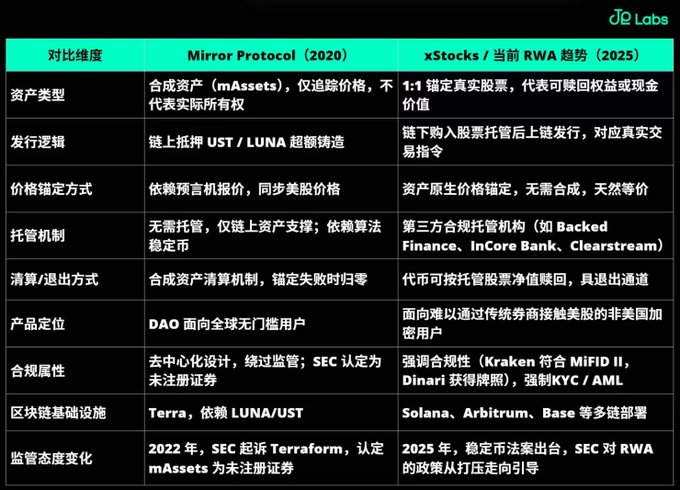From mAssets to xStocks: Five Years of U.S. Stock Tokenization
In July 2025, Robinhood announced that users can trade U.S. stocks 24 hours a day, 5×24 hours on the Arbitrum chain; Bybit and Kraken Announce the Listing of xStocks Powered by Backed Finance, a Swiss-compliant asset tokenization platform; Coinbase has applied to the SEC to issue tokenized securities. The market has been hotly discussed for a while, and speculating on U.S. stocks on the chain has become the focus of users' attention.
Is this the first time that U.S. stocks have been put on the chain?
As early as the summer of DeFi in 2020, Mirror Protocol launched mAssets, a synthetic asset on the Terra chain, which enables "holding" U.S. stocks such as Apple and Tesla without KYC or opening an account with a brokerage. At that time, Mirror was in high spirits, but it eventually disappeared with the collapse of Luna and the heavy supervision of the SEC.
Five years later, a new generation of U.S. stock tokenization products such as xStocks made a comeback. How do they differ from Mirror in terms of asset structure, compliance, technology stack, etc.? Can U.S. stock tokenization go further this time?
1. Comparison of asset structure: from on-chain mapping to real anchoring
Mirror Protocol's mAssets are essentially on-chain price synthetic assets. It does not represent any real-world shareholding or asset ownership, but only synchronizes the real U.S. stock price through an oracle to simulate a "price-pegged but de-anchored" synthetic target with a smart contract. The issuance of mAssets relies on the over-collateralized algorithmic stablecoin UST, and once there is a systemic risk in the underlying stability mechanism, such as the collapse of the Terra ecosystem in May 2022 (UST de-anchoring), the entire asset system will immediately fall into a chain reaction of value zero. The core problem with this structure is that it is anchored to a "price" rather than an "equity" or "asset", and its essence is closer to a derivative than a certificate of ownership.
In contrast, xStocks uses a completely different asset-anchoring structure. Initiated by Swiss compliance agency Backed Assets, it has a clear underlying asset structure and verifiable off-chain: real shares are purchased through brokerages such as Interactive Brokers, and then held in custody by regulated custodians such as Clearstream, InCore Bank, Maerki Baumann, etc. The generation of tokens adopts the method of "buy first, then put on the chain", so that each xStock token corresponds to the real stock position, ensuring that each token corresponds to the real position 1:1. In short, every on-chain purchase made by a user is anchored by a real stock transaction.
xStocks' tokens are issued on the Solana public chain using the SPL standard, supporting 5×24-hour on-chain trading and instant settlement, breaking the limitations of the traditional securities market on working days and trading hours. More importantly, compared to the vulnerability of DeFi synthetic asset system such as Mirror in extreme market conditions, xStocks' asset structure introduces real assets, compliant custody and on-chain auditable mechanisms, getting rid of the bubble of DeFi synthetic assets that can be broken at the first poke.
2. Comparison of compliance logic: from gray area to compliance
The birth of Mirror Protocol coincided with the window period of the DeFi explosion in 2020, when the on-chain ecological regulatory vacuum and experimental frenzy coexisted. At that time, KYC/AML was not common, but instead defaulted to anonymous, non-censorship, borderless transactions. It was at this time that Mirror was born, where users can mint mAssets by staking UST or LUNA without identity verification, and freely trade TSLA, AAPL and other U.S. stock mapping assets, enabling global users to trade U.S. stocks 24/7.
However, this model based on synthetic assets + algorithmic stablecoin support lacks supervision and real assets, which also lays hidden dangers in the future. In 2022, as the LUNA/UST crash caused a global shock, the SEC filed charges against Mirror and Terraform Labs, explicitly characterizing mAssets as "unregistered securities." Since then, on-chain synthetic assets have faced a regulatory winter, and the Mirror model has become a typical example of experimental failure, which also marks the end of the first generation of Web3's path to real-world financial mapping.
Today, xStocks is driven by TradFi + Web3 hybrids such as Kraken, Robinhood, and Backed Finance, which have compliance resources and traditional financial backgrounds. Kraken complies with the European Union's MiFID II directive, and both Backed Assets and Dinari are licensed to issue securities tokens; Transactions require KYC/AML verification, and the off-chain settlement process can be traced. In 2025, Paul Atkins, chairman of the new US SEC, called tokenization a "financial digital revolution", and the policy wind has also shifted from suppression to guidance.
It's important to know that xStocks is not an equity token, but a bond-structured tracker asset that is essentially closer to a transferable stablecoin + certificate of income. Although this structure can circumvent the high barriers to the regulation of securities attributes, it also leads to the fact that it does not have voting rights and corporate governance rights, and involves a more complex structure involving dividends and distribution, which needs to be distributed through an intermediary entity (such as Kraken's Bermuda subsidiary PDSL), and although the bond model brings compliance advantages in terms of tax and registration (such as no stamp duty and bearer), it also distances xStocks from the narrative of "on-chain ownership of U.S. stocks", and some users said, " On-chain stock tokens are more like castrated stocks for tax avoidance"
3. Comparison of technology stacks: ecological closure vs protocol integration
Mirror Protocol is built on the Terra chain, and the ecosystem mainly relies on the internal circulation of LUNA and UST. Although the functions of Terraswap and Anchor Protocol were relatively mature at that time, they were limited by the single ecology and it was difficult to achieve cross-chain collaboration.
xStocks chooses to be deployed on multi-chain high-performance public chains (such as Arbitrum, Solana, Base) with cross-chain asset circulation, and the tokens of xStocks can be used for lending and LP mining of the Solana DeFi protocol, gradually moving closer to on-chain composability.
However, the trading experience of xStocks still suffers from illiquidity. At present, its on-chain liquidity is highly concentrated in a very small number of targets, such as TSLAx, SPYx, etc., with a large number of asset pool transactions less than 20, serious slippage, and a lack of liquidity support mechanism. Further, xStocks still lacks a deep integration mechanism similar to perp DEX on the chain, resulting in a significant gap between the overall trading experience and contracts on CEXs and CFD products on US stocks, which is difficult to meet the needs of large-scale traffic migration or high-frequency trading in the short term.
-
According to DeFioasis on-chain data, on June 30, 2025, the first day of the product's launch, the on-chain transaction volume was $1.338 million, the number of independent trading users was 1,225, and the number of transactions was 2,510.
-
Despite the significant increase in volume on July 1, with the volume rising to $6.64 million, the number of new unique traders reaching 6,565, and the number of transactions jumping to 17,879, the number of transactions is still concentrated in a small number of targets.
-
The transactions are mainly distributed in TSLAx ($1.71 million), SPYx ($1.53 million), CRCLx ($940,000) and other head assets, and most of the rest of the underlying transactions are extremely limited, and some asset pools even have zero liquidity, which is difficult to support effective matchmaking.

Fourth, the current ecological picture of U.S. stock tokenization
-
StableStocks: StableStocks is a CeDeFi company focusing on the onchain stock ecosystem, and is committed to bridging the complete closed loop of the onchain stock ecosystem. Its tokenization path relies on its self-built compliant brokerage system and asset mapping technology to provide users with the ability to directly invest in real-world high-quality stocks through stablecoins. Its core goal is to realize the holding, lending, trading and derivatives construction of traditional stock assets on the chain, and open up the cross-platform liquidity of the same Onchain Stock, so as to improve the depth and efficiency of on-chain assets. Its product structure allows users to enter the U.S. stock market in the form of stablecoins, and plans to cover a variety of underlying assets including blue chips, ETFs and thematic assets in the future.
-
xStocks: xStocks is currently the largest U.S. stock trading volume on the chain, carrying nearly 90% of on-chain liquidity. Its compliance structure is based on the Swiss DLT Act and the dual SPV (Special Purpose Vehicle) structure in Liechtenstein and Jersey to ensure legal compliance on the issuing side. xStocks' tokens are based on the Solana public chain, adopt the SPL standard, and introduce the Chainlink price feed mechanism, which enables high-frequency synchronization of prices with the off-chain market.
-
Robinhood: As a representative of traditional brokerages entering Web3, Robinhood focuses on the "compliance first" and "ecological closed-loop" model. Its European operations are regulated by the Central Bank of Lithuania and have obtained the MiFID II and MiCAR cryptoasset licenses, and are qualified to issue security tokens within the EU. Robinhood currently deploys a stock tokenization prototype on the Arbitrum layer 2 network, and plans to launch its self-developed proprietary L2 in the future to achieve a closed technology loop under regulatory compliance.
-
Coinbase: As the infrastructure leader in the U.S. market, Coinbase's tokenization path is directly influenced by the pace of SEC policy advancement. At present, Coinbase is waiting for regulatory exemptions to activate its licensed subsidiaries to carry out clearing, custody, compliance reporting and other business links, with the goal of achieving native and compliant issuance of U.S. stock assets on the chain. Coinbase's tokenization module is deployed on its self-developed Base layer 2 network, and the first batch of 50–100 U.S. stocks and ETFs is expected to be listed, covering standard blue chips and some thematic assets, and will support dividend distribution and on-chain settlement.
In the context of the gradual implementation of the stablecoin bill, the market has paid great attention to compliance and tokenization. While stock tokenization is not meant to replace the traditional stock market, the greatest value of stock tokenization lies in the connection, opening the door to the crypto world for traditional investors, and also providing crypto users with tools to anchor real-world assets. Just as the launch of Bitcoin and Ethereum ETFs has made it possible for mainstream capital to enter the crypto market, stock tokenization is also expected to be an important channel for the next round of capital inflows.
Auther: @crypto_crane888
Powered by: @JELabs2024
